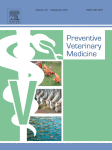Ver ítem
- xmlui.general.dspace_homeCentros Regionales y EEAsCentro Regional Tucumán - Santiago del EsteroEEA QuimilíArtículos científicosxmlui.ArtifactBrowser.ItemViewer.trail
- Inicio
- Centros Regionales y EEAs
- Centro Regional Tucumán - Santiago del Estero
- EEA Quimilí
- Artículos científicos
- Ver ítem
Strategic control of Rhipicephalus (Boophilus) microplus infestation on beef cattle grazed in Panicum maximum grasses in a subtropical semi-arid region of Argentina
Resumen
The aim of this work was to test the efficacy of strategic control methods of Rhipicephalus microplus infestation on beef cattle grazed in Panicum maximum grasses in northwestern Argentina. Also, an analysis to discern how the R. microplus population was distributed amongst cattle was also performed to determine if partial selective treatment or cull the small proportion of more heavily infested animals are feasible options to control this tick. The
[ver mas...]
The aim of this work was to test the efficacy of strategic control methods of Rhipicephalus microplus infestation on beef cattle grazed in Panicum maximum grasses in northwestern Argentina. Also, an analysis to discern how the R. microplus population was distributed amongst cattle was also performed to determine if partial selective treatment or cull the small proportion of more heavily infested animals are feasible options to control this tick. The strategic scheme of treatments was designed to act on the small 1st generation of R. microplus in early spring and prevent in that way the appearance of the annual peak of abundance of R. microplus in summer and autumn. Animals of the group 1 were treated with ivermectin 3.15% on day 0 (25th September 2015), with fluazuron on day 32 (27th October 2015) and with fipronil on day 75 (9th December 2015). Animals of group 2 formed the control group. The overall effect of the treatments was positively significant. The number of ticks observed on the control group was significantly higher than the number of ticks observed on the treated group in all post-treatment counts (P < 0.01), with the only exception of the count of March. The distribution of parasites among cattle in all counts was adjusted to the negative binomial distribution, but a temporal variation in the tick aggregation levels associated to changes in tick abundance was found. The higher the abundance of R. microplus, the lower the aggregation. It was found that the steers (15.8% of the total number of animals evaluated) belonging to the high infestation group accounted for 23.0% of the total ticks. The strategic control method evaluated during this study provides a remarkable overall effect against R. microplus because it significantly reduces the tick infestation on cattle with only three applications of acaricides in one-year period. The analyses of tick distribution amongst cattle suggest that partial selective treatment and culling do not represent feasible methods to control R. microplus infestation on cattle.
[Cerrar]

Fuente
Preventive veterinary medicine 144 : 179-183. (September 2017)
Fecha
2017-09
ISSN
0167-5877 (Print)
1873-1716 (Online)
1873-1716 (Online)
Formato
pdf
Tipo de documento
artículo
Palabras Claves
Derechos de acceso
Restringido
 Excepto donde se diga explicitamente, este item se publica bajo la siguiente descripción: Creative Commons Attribution-NonCommercial-ShareAlike 2.5 Unported (CC BY-NC-SA 2.5)
Excepto donde se diga explicitamente, este item se publica bajo la siguiente descripción: Creative Commons Attribution-NonCommercial-ShareAlike 2.5 Unported (CC BY-NC-SA 2.5)

